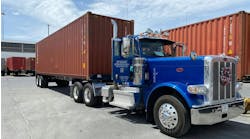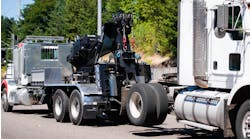Between the ten consecutive hours of downtime required by hours-of-service regulations and the harshness of recent winters, drivers in the coming months can expect to wake up to winter wonderlands that were not there when their heads hit the pillow. As a trucking professional, you are certainly aware of the trials and tribulations of driving in these conditions, which always seem to get a lot of press. There is a danger, however, that does not get much coverage — piles of snow and ice on top of trailers.
A winter wonderland becomes dangerous when snow and ice slide from atop a trailer while in transit. Both can damage windshields or temporarily obstruct the views of fellow motorists, leading to accidents. Furthermore, many carriers that I have spoken with have often found themselves paying claims to motorists who have had windshields damaged due to ice falling from the trailer.
Aside from the on-road dangers that exist, the added weight could put your unit over a weight limit. Once a driver gets to a weigh station, if he or she is loaded close to 80,000 lbs., the additional snow and ice may move the vehicle over that threshold, and the driver may be forced to find a way to remove the excess snow and ice in order to get back under the weight limit and continue the trip. Operationally speaking, overweight trucks burn more fuel, increase travel time and require longer braking distances than trucks loaded to the legal limit.
At this point, one might ask why the driver doesn't just climb on top of the trailer and remove the snow. Well, I believe our friends at the Occupational Safety and Health Administration would have some serious issues with drivers walking on snow and ice roughly 14 ft. in the air. Secondly, if that driver were to fall and be injured, the workers' compensation claim may prove to be extremely costly, not to mention that carriers would not want to encourage unsafe behavior.
Some states have instituted citations for failing to remove snow and ice. On Oct. 22 of this year, New Jersey passed a law requiring drivers to remove snow and ice from their vehicles prior to traveling or face fines of between $25 and $75. Also, Ohio prohibits snow- and ice-laden trucks from traveling on its Turnpike until the snow and ice are removed. While more and more states are requiring removal, none are providing the guidance or resources needed to accomplish the task.
According to most carriers that I have spoken with, truck washes remain the most effective way to remove snow and ice, but drivers still have to get their equipment to a facility. With fewer than 1,000 truck washes in the U.S., it becomes a roll of the dice for drivers to find one before the accumulated snow and ice falls off their trailers and onto other vehicles.
While motor carriers consistently strive to make our roadways safe for all users, snow and ice accumulation on trailer tops is an inevitable winter occurrence. Until we can find a permanent solution, I encourage all regulating authorities to examine this problem in its entirety prior to passing legislation that will cite, fine or even place a driver out of service for weather-related circumstances. In other words, while we join efforts to effectively and consistently make our roadways safer, we also encourage a search for real and practical solutions to a problem that won't just melt away.
David Heller, CDS, is director of safety and policy for the Truckload Carriers Assn., responsible for interpreting and communicating industry-related regulations and legislation to the membership of TCA. Send comments to Mr. Heller at [email protected].


